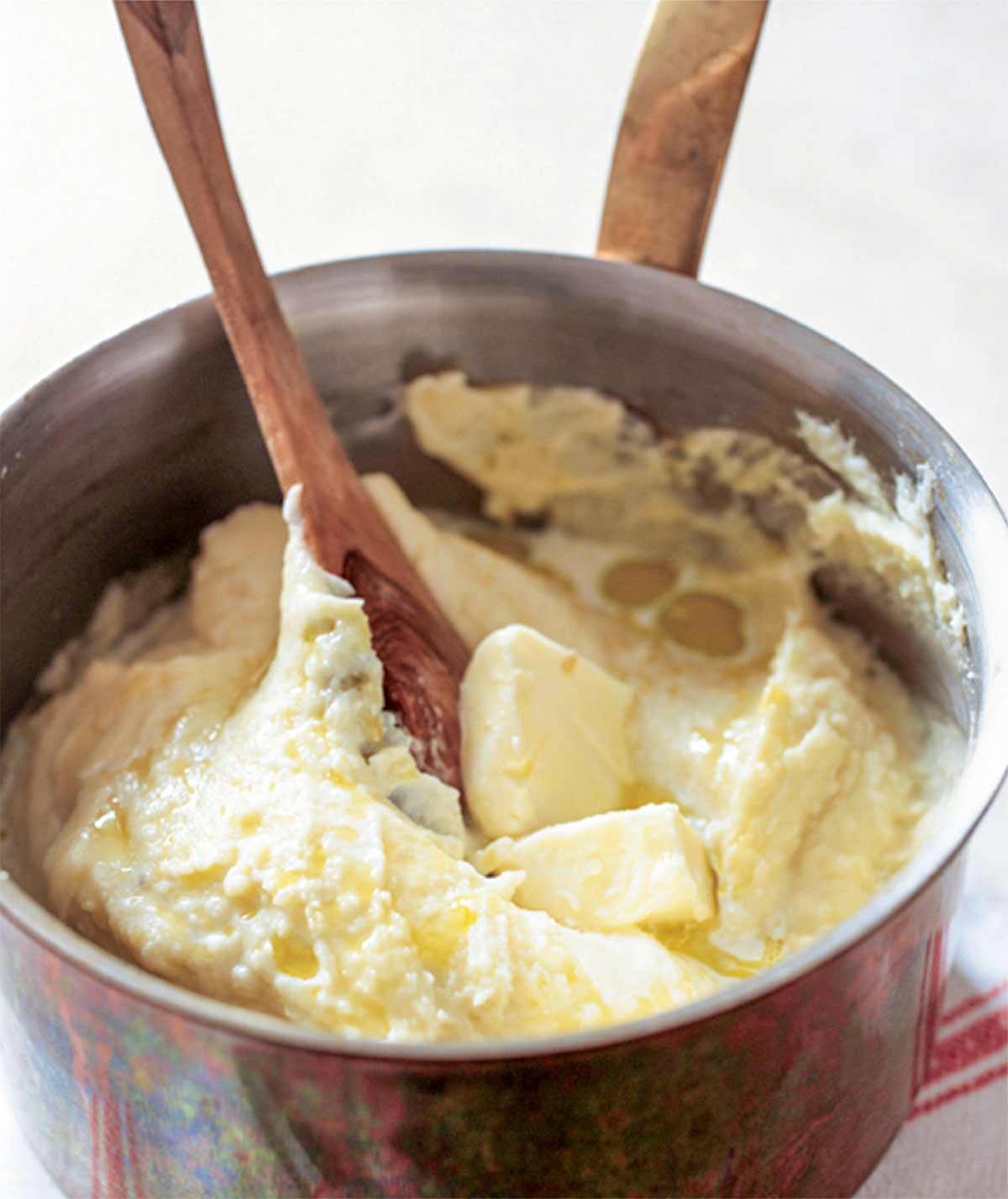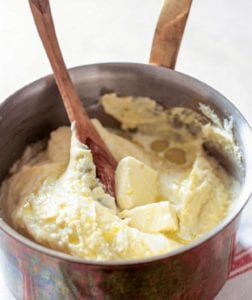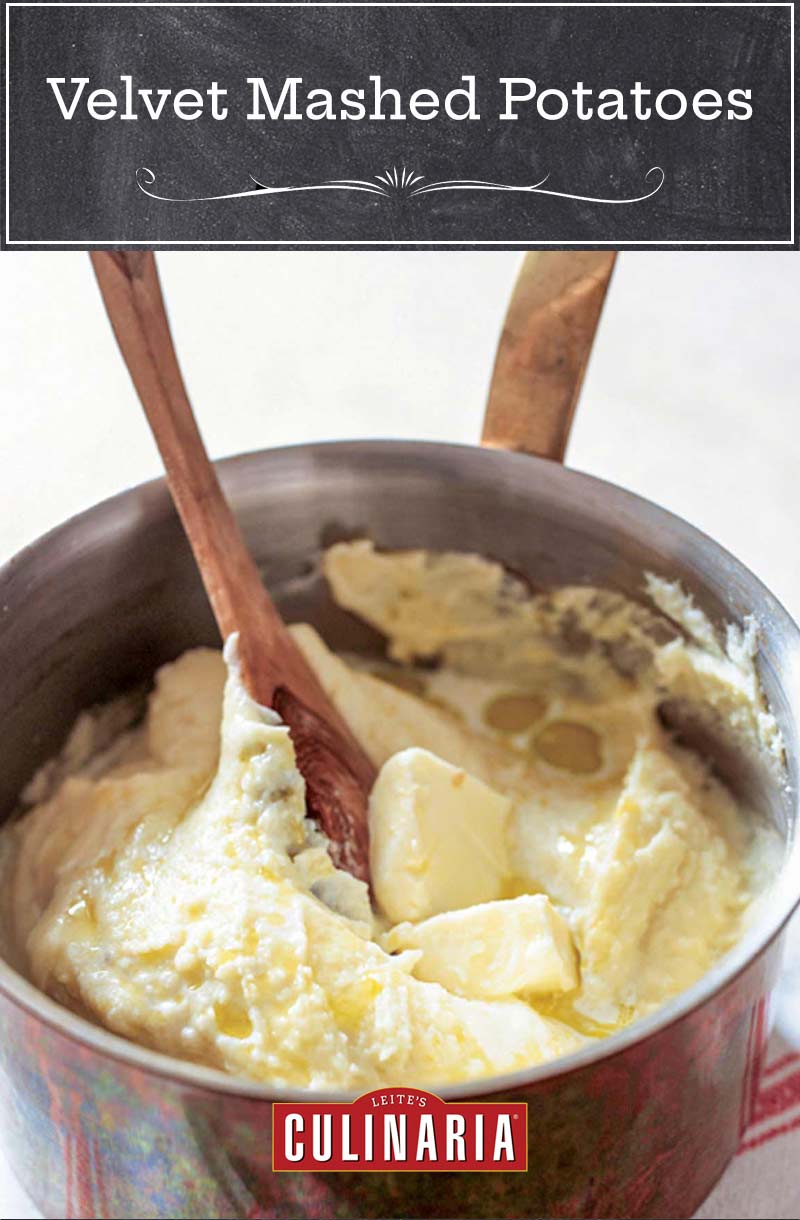
No mere mash, these velvety mashed potatoes are obscenely creamy and buttery and rich and (insert countless other adjectives for things that you want on your table when you’re in the mood for a splurge). Just a few ingredients and a single, simple, superlative technique that relies on a truly indispensable piece of kitchen equipment known as a ricer that ensures a velvety smooth consistency without fail. What are you doing still reading? Go make yourself some mashed potatoes.–Tyler Florence
Velvet Mashed Potatoes FAQs
Simply place the pot of finished mash atop or inside another larger pot of gently simmering water and partially cover the pot containing the mashed potatoes, using a wooden spoon stuck in the pot to keep the lid slightly ajar. When it comes time to serve, if the mash looks a little dry, simply add a little extra cream (or milk) and butter for good measure.
All root vegetables cook better when started in cold water. First, it helps to remove some of that excess starch which can make them sticky when cooked. But more importantly, if you just dump all those potatoes into boiling water, the outside will cook faster and you’ll end up with unevenly cooked taters.
Yes! A food mill is a little more aggressive but not so much that you’re going to end up with anything upsetting and gluey. It will do about the same thing and you’ll get a remarkably similar result, so whichever gadget that you have on hand, you’re good to go. Good to potato?

Velvet Mashed Potatoes
Equipment
- Potato ricer
Ingredients
- 3 large Yukon Gold potatoes, peeled and quartered
- Kosher salt
- 1 cup heavy cream
- 4 tablespoons (1/2 stick) unsalted butter
- Freshly ground black pepper
- Extra-virgin olive oil, (optional)
Instructions
- Place the potatoes in a medium saucepan and add enough cold water to cover. Add 1 teaspoon salt, bring to a boil, reduce the heat, and simmer until the potatoes are very tender when pierced with a fork, 15 to 20 minutes.
- While the potatoes cook, in a small saucepan over medium heat, warm the cream with the butter until the butter melts. Remove from the heat.
- Drain the potatoes and pass them through a potato ricer into a large bowl. Stir in the warm cream and butter, mixing just until the liquid is absorbed and the mixture is smooth. Season with salt and pepper and stir in a drizzle of olive oil, if desired.

Nutrition
Nutrition information is automatically calculated, so should only be used as an approximation.
Recipe Testers’ Reviews
These velvet mashed potatoes are spud seduction. The recipe is written clearly, the ingredients are easily accessible, and the results are amazing.
The true key here is using the potato ricer and bringing all the ingredients to the same temperature, allowing for the cream, butter, and potatoes to waltz happily into a velvety potato party in your mouth.
Using a ricer makes these velvet mashed potatoes so smooth and creamy. Next time, I’d leave the potatoes to dry in the pan for a few minutes after draining. I had to add some salt to the finished potatoes, but I think next time I would use salted butter. They certainly didn’t need the olive oil, but it did look pretty. We loved them.
Perfection. The only adjustment I would make would be to salt the water more. I have a heavy hand there, to be sure, but I feel it makes a difference.
This simple velvet mashed potatoes recipe is perfect with a juicy meat dish, which would incorporate well with this recipe. The mashed potatoes were creamy and velvety, much as the recipe’s title implies, and can be done in no time. Perfect for a fast side dish on a weeknight.
I think the flavor is excellent and this purée can be served with many different types of meat and seafood. It’s truly more of a purée than what I would call a mash. If mashed potatoes are what you want, you should simply add less cream, probably no more than 3/4 cup rather than the full cup stated in the recipe.
My 3 rather large Yukon Gold potatoes weighed about 1 1/2 pounds. Perhaps if 2 pounds of potatoes were used the consistency would have been a bit better, i.e., still able to be eaten with a spoon if desired, but having a bit more structure on the plate.
Everyone I know loves mashed potatoes, so when you sneak something in front of them and call it purée, you know what the reaction will be. “Yuck! Purée—that’s baby food! I hate it — why can’t we have regular mashed potatoes?” Fast-forward about five minutes, and all you can hear is the soft humming of contented diners smiling and swinging their feet to some favorite tune in their head. “Wow! THIS is what potato purée is?” “I think I want to be a baby again!” Yes, this recipe is just that good. Smooth, velvety, warm, creamy, and seductive as you close your mouth around “just one more bite” of this potato puree.
I’ve always used a ricer, so I knew what to expect in the way of texture. I usually cook the potatoes with the skins on, however, because peeling them is not necessary with the ricer—it does the job for me. I didn’t use the drizzle of olive oil at the end. Why not? So I would have the excuse to make this recipe again and try it that way!
This is a great rendition of mashed potatoes.
The recipe is simple, with few ingredients, and results in delicious and rich potatoes. There’s still some effort involved, with the use of the ricer, but it’s worth the extra time because the potatoes seemed almost lighter, even though this is definitely not a low-calorie or low-fat dish.
I used the ricer disc with the smallest holes and the potatoes were quite smooth—not baby food purée smooth, but definitely no large lumps that lend smashed potatoes their rustic feel. I wish the ingredients list specified pounds of potatoes instead of the number of potatoes.
This is pretty much how I always make mashed potatoes but without a recipe. I just throw in a little butter and cream until they look and taste just right. I had no idea I was using that much cream, but when I used up the full cup of cream, they were just right (knowing they thicken a little as they sit).
I finished making the potatoes and was getting ready to take a turkey out of the oven and asked everyone to taste the potatoes before I started on the turkey gravy. They said it was torture to give them only one bite until dinner was ready, so I figured it’s worth the tester’s designation.















Rich and delicious. Probably wise to leave your diet in another room when eating these – but it’s worth it.
I never made mashed potatoes with a ricer before. It was easy and the results were wonderful – no lumps and beautifully smooth.
Dean, I love your sense of humor—leaving your diet in the other room is sage advice! I’m thrilled you gave the ricer a try; it truly is a game-changer for silky, lump-free mashed potatoes. Thanks for sharing your experience, and I hope this becomes a go-to indulgence for you.
If I had to choose my last dinner, mashed potatoes would be on the plate! I’m always interested in trying new versions and this dish was very good…not the absolute best mash I have eaten, but far from the worst. I kept to the recipe–using freshly dug Yukon Golds from my local CSA. The resulting texture was superb–smooth, creamy and melt-in-your-mouth soft. I love using the ricer. It’s nice to know that none of your guests will end up with a lump of unmashed spud! One cup of cream and half a stick of butter was generous (even for someone who loves her fats!). As much as I enjoyed making these, I could almost feel them settling on the hips! I feel like the amount of cream could be reduced slightly without too much impact on the taste. I also like to boil my potatoes in chicken stock and with a couple of garlic cloves thrown in for added depth. All in all though, really delicious, simple to prepare, and would make a lovely base for a number of different proteins.
Tania, hips schmips! Make these only a few times a year, and your hips will never notice. You guests, on the other hand, will!
Could not agree more, Tania. Mashed potatoes go with everything!
I’m bad…I have not made this recipe but have made a similar one using a ricer for the first time. I could not get the potatoes to come together smoothly. What did I do wrong? When eating the potatoes they still had “chew” of grains of rice.
Merry S., it sounds like the potatoes needed to cook a touch longer. Whenever I’ve used a ricer, it works to a faretheewell. Next time, when you boil the potatoes, boil them a touch longer, until they almost fall apart with the prod of a fork. Hope this helps.
Merry, Renee is absolutely correct. I use a potato ricer all the time. And if I somehow undercook the potatoes, there’s a bit of a chew to the final dish, due to the small pieces of partially cooked potatoes. Cook them a little longer, and you’ll be fine.